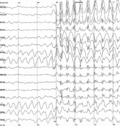Post-traumatic epilepsy

Editor-In-Chief: Prab R Tumpati, MD
Obesity, Sleep & Internal medicine
Founder, WikiMD Wellnesspedia &
W8MD medical weight loss NYC and sleep center NYC
| Post-traumatic epilepsy | |
|---|---|

| |
| Synonyms | N/A |
| Pronounce | N/A |
| Specialty | N/A |
| Symptoms | Seizures, loss of consciousness, confusion, memory loss |
| Complications | N/A |
| Onset | Days to years after traumatic brain injury |
| Duration | Chronic |
| Types | N/A |
| Causes | Traumatic brain injury |
| Risks | Severity of injury, penetrating head injury, intracranial hemorrhage |
| Diagnosis | EEG, neuroimaging |
| Differential diagnosis | Non-epileptic seizures, syncope, migraine |
| Prevention | N/A |
| Treatment | Antiepileptic drugs, surgery |
| Medication | N/A |
| Prognosis | Variable, depends on severity and response to treatment |
| Frequency | 10-20% of traumatic brain injury cases |
| Deaths | N/A |
Post-traumatic epilepsy (PTE) is a form of epilepsy that results from brain damage caused by physical trauma to the brain (traumatic brain injury, TBI). This can be due to falls, car accidents, gunshots, sports injuries, and military combat. PTE is a chronic condition that can develop months or even years after a traumatic brain injury.
Causes[edit]
The exact cause of PTE is not known, but it is believed to be due to changes in the brain caused by the injury. This can include damage to the brain's neurons, changes in the brain's structure, or the formation of scar tissue. Some studies have suggested that the severity and location of the injury, as well as the patient's age and genetics, may also play a role in the development of PTE.
Symptoms[edit]
The symptoms of PTE are similar to those of other forms of epilepsy. They can include seizures, which can be characterized by a loss of consciousness, uncontrolled movements, and changes in behavior or sensation. Other symptoms can include memory problems, mood changes, and difficulty with concentration or attention.
Diagnosis[edit]
The diagnosis of PTE is typically made based on the patient's history of traumatic brain injury and the presence of seizures. Imaging tests such as MRI or CT scan can be used to identify any structural changes in the brain that could be causing the seizures. In some cases, an electroencephalogram (EEG) may be used to monitor the brain's electrical activity and identify any abnormal patterns.
Treatment[edit]
The treatment for PTE typically involves the use of anti-seizure medications. These can help to control the seizures and prevent them from occurring. In some cases, surgery may be considered if the seizures are not controlled with medication. This can involve removing the area of the brain that is causing the seizures, or implanting a device to help control the brain's electrical activity.
Post-traumatic epilepsy images[edit]
-
EEG showing spike-wave discharges
-
3D model of Carbamazepine molecule
-
Portrait of Benjamin Winslow Dudley
See also[edit]
Ad. Transform your life with W8MD's Budget GLP-1 injections from $75


W8MD offers a medical weight loss program to lose weight in Philadelphia. Our physician-supervised medical weight loss provides:
- Weight loss injections in NYC (generic and brand names):
- Zepbound / Mounjaro, Wegovy / Ozempic, Saxenda
- Most insurances accepted or discounted self-pay rates. We will obtain insurance prior authorizations if needed.
- Generic GLP1 weight loss injections from $75 for the starting dose.
- Also offer prescription weight loss medications including Phentermine, Qsymia, Diethylpropion, Contrave etc.
NYC weight loss doctor appointmentsNYC weight loss doctor appointments
Start your NYC weight loss journey today at our NYC medical weight loss and Philadelphia medical weight loss clinics.
- Call 718-946-5500 to lose weight in NYC or for medical weight loss in Philadelphia 215-676-2334.
- Tags:NYC medical weight loss, Philadelphia lose weight Zepbound NYC, Budget GLP1 weight loss injections, Wegovy Philadelphia, Wegovy NYC, Philadelphia medical weight loss, Brookly weight loss and Wegovy NYC
|
WikiMD's Wellness Encyclopedia |
| Let Food Be Thy Medicine Medicine Thy Food - Hippocrates |
Medical Disclaimer: WikiMD is not a substitute for professional medical advice. The information on WikiMD is provided as an information resource only, may be incorrect, outdated or misleading, and is not to be used or relied on for any diagnostic or treatment purposes. Please consult your health care provider before making any healthcare decisions or for guidance about a specific medical condition. WikiMD expressly disclaims responsibility, and shall have no liability, for any damages, loss, injury, or liability whatsoever suffered as a result of your reliance on the information contained in this site. By visiting this site you agree to the foregoing terms and conditions, which may from time to time be changed or supplemented by WikiMD. If you do not agree to the foregoing terms and conditions, you should not enter or use this site. See full disclaimer.
Credits:Most images are courtesy of Wikimedia commons, and templates, categories Wikipedia, licensed under CC BY SA or similar.
Translate this page: - East Asian
中文,
日本,
한국어,
South Asian
हिन्दी,
தமிழ்,
తెలుగు,
Urdu,
ಕನ್ನಡ,
Southeast Asian
Indonesian,
Vietnamese,
Thai,
မြန်မာဘာသာ,
বাংলা
European
español,
Deutsch,
français,
Greek,
português do Brasil,
polski,
română,
русский,
Nederlands,
norsk,
svenska,
suomi,
Italian
Middle Eastern & African
عربى,
Turkish,
Persian,
Hebrew,
Afrikaans,
isiZulu,
Kiswahili,
Other
Bulgarian,
Hungarian,
Czech,
Swedish,
മലയാളം,
मराठी,
ਪੰਜਾਬੀ,
ગુજરાતી,
Portuguese,
Ukrainian





